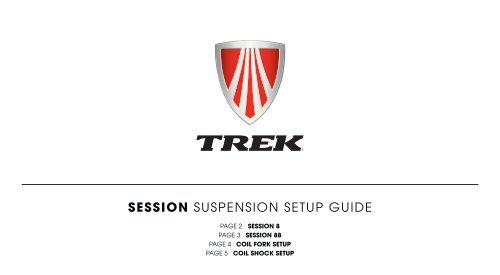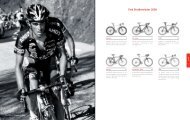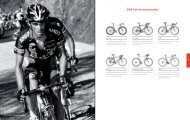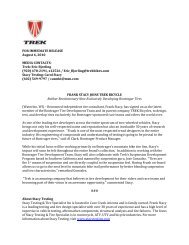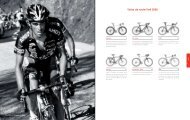SeSSion SUSpeNSION SeTUp gUIDe
SeSSion SUSpeNSION SeTUp gUIDe
SeSSion SUSpeNSION SeTUp gUIDe
You also want an ePaper? Increase the reach of your titles
YUMPU automatically turns print PDFs into web optimized ePapers that Google loves.
SESSION SUSPENSION SETUP GUIDE<br />
page 2 Session 8<br />
page 3 Session 88<br />
page 4 Coil fork setup<br />
page 5 Coil SHOCK setup
Suspension Setup Guide (session 8)<br />
Bike Session 8<br />
Travel<br />
Shock stroke<br />
Shock Sag %<br />
Shock eye-to-eye at<br />
recommended sag<br />
Fork Sag %<br />
Suspension<br />
Front<br />
RockShox Boxxer Race<br />
203mm<br />
70mm<br />
25-35% - sitting on bike<br />
190 - 198mm<br />
20-25% - standing on bike<br />
Rear<br />
Fox Van RC<br />
Rider Weight (lbs)<br />
Spring<br />
Rebound<br />
(clicks in)<br />
Compression<br />
(clicks in)<br />
Spring<br />
(lb/in)<br />
Rebound<br />
(clicks out)<br />
Compression<br />
(clicks out)<br />
Under 120 Silver 8 1 300 14 12<br />
120-140 Yellow 8 1 350 12 10<br />
140-160 Red (std S) 10 2 400 (std S) 10 10<br />
160-180 Red (std M) 12 2 450 (std M) 8 8<br />
180-200 Blue (L) 14 3 450 (std M) 8 8<br />
200-220 Black 16 4 500 (std L) 6 6<br />
Over 220 Black 16 4 550 4 6<br />
2
Suspension Setup Guide (session 88)<br />
Bike Session 88<br />
Travel<br />
Shock stroke<br />
Shock Sag %<br />
Shock eye-to-eye at<br />
recommended sag<br />
Fork Sag %<br />
203mm<br />
70mm<br />
25-35% - sitting on bike<br />
190 - 198mm<br />
20-25% - standing on bike<br />
Suspension<br />
Front<br />
Fox 40 Fit RC2<br />
Rear<br />
Fox DHX RC4<br />
Rider Weight (lbs)<br />
Spring<br />
Low Speed<br />
Compression<br />
(clicks out)<br />
High Speed<br />
Compression<br />
(clicks out)<br />
Rebound<br />
(clicks out)<br />
Spring<br />
(lb/in)<br />
Boost Valve<br />
(PSI)<br />
Boost Valve<br />
Progression<br />
(turns out)<br />
Low Speed<br />
Compression<br />
(clicks out)<br />
High Speed<br />
Compression<br />
(clicks out)<br />
Rebound<br />
(clicks out)<br />
Under 120 Purple 12 14 10 300 140 3.5 12 12 14<br />
120-140 Purple 10 12 10 350 160 3.5 10 12 12<br />
140-160 Blue (std S) 10 12 8 400 (std S) 160 3.5 10 11 10<br />
160-180 Blue (std M) 8 10 8 450 (std M) 160 3.5 9 10 8<br />
180-200 Blue (std M) 8 10 8 450 (std M) 160 3.5 9 10 8<br />
200-220 Green (std L) 6 10 7 500 (std L) 160 2 7 8 6<br />
Over 220 Yellow 6 8 6 550 160 2 6 8 4<br />
3
COIL FORK Suspension Setup Guide<br />
(session 88 only)<br />
Tools needed to adjust Fox fork :<br />
Fork sag indicator<br />
A person to hold you up<br />
Follow these steps to optimize the performance of your Trek Full Suspension Mountain Bike front suspension:<br />
1.<br />
2.<br />
3.<br />
4.<br />
5.<br />
6.<br />
7.<br />
8.<br />
9.<br />
10.<br />
Install suggested spring rate based on rider weight (include rider + gear)<br />
Adjust high speed compression [RC2 only]<br />
a) Turn adjustment knob clockwise until knob stops – this is your base setting<br />
b) Turn knob counter-clockwise to your recommended setting.<br />
Adjust low speed compression [RC2 only]<br />
Turn adjustment knob clockwise until knob stops – this is your base setting<br />
Turn knob counter-clockwise to your recommended setting<br />
Adjust rebound<br />
a) Turn adjustment knob clockwise until knob stops – this is your base setting<br />
b) Turn knob counter-clockwise to your recommended setting<br />
Make sure the coil is preloaded properly<br />
a) Turn spring preload adjustment knob counter-clockwise to minimum setting.<br />
Mount bike and have your friend hold you up. Cycle fork, settling into a standing riding stance centered on the bike. Slide o-ring on stanchion down to contact seal head.<br />
Dismount and check o-ring placement in comparison to sag indicator marks. Compare your measurement with the suggested fork sag range.<br />
a) If sag is too great, you can turn preload adjustment knob as necessary. If you reach maximum preload adjustment range and you still have too much sag, it is recommended that you go up to the next spring rate.<br />
b) If sag is too little and you are at minimum preload, it is recommended that you go to the next softer rate.<br />
c) If you do not achieve proper sag, swap to the appropriate spring and repeat steps #1-8.<br />
It’s important to note that spring rate is a highly personal setting. Some riders prefer a firmer spring rate for more control on big hits, while others prefer a lower spring rate for optimized suspension performance on lowerspeed<br />
technical terrain. Consider riding a variety of spring rates to determine your optimal setting.<br />
4
COIL SHOCK Suspension Setup Guide<br />
(session 88 only)<br />
Tools needed [for bikes with Fox coil rear shocks]<br />
17mm socket and ratchet (Fox RC4 only]<br />
tape measure<br />
A person to measure shock eye-to-eye<br />
Follow these steps to optimize the performance of your Trek Full Suspension Mountain Bike rear suspension:<br />
1. Install suggested spring rate based on rider weight [include rider + gear]<br />
2.<br />
3.<br />
4.<br />
5.<br />
6.<br />
7.<br />
8.<br />
9.<br />
Adjust high speed compression [RC4 only]<br />
a. Using a 17mm socket and ratchet, turn adjustment knob clockwise until knob stops – this is your base setting<br />
b. Turn knob counter-clockwise to your recommended setting. You will feel clicks when turning with the 17mm socket and ratchet.<br />
Adjust low speed compression<br />
a. Turn adjustment knob clockwise until knob stops – this is your base setting<br />
b. Turn knob counter-clockwise to your recommended setting<br />
Adjust rebound<br />
a. Turn adjustment knob clockwise until knob stops – this is your base setting<br />
b. Turn knob counter-clockwise to your recommended setting<br />
Make sure the coil is preloaded properly<br />
a. Loosen the collar until the coil is in a fully decompressed state, with the collar tight enough to prevent loose movement of the coil.<br />
b. Turn the collar clockwise one full turn.<br />
Mount bike and cycle shock, settling into a seated riding stance<br />
Have your friend measure the eye-to-eye of the shock<br />
Compare your measurement with the suggested shock sag range (refer to setup table).<br />
a. If sag is too great, turn coil collar clockwise up to 2 full turns.<br />
IMPORTANT: do not turn collar more than 3 total turns from a fully relaxed state, as spring could coil bind before full travel.<br />
b. If sag is too little and you are at 1 turn in, it is recommended that you go to the next softer rate. The spring must have a minimum of half a turn of preload, but this is an indication that you need the next softer rate.<br />
c. If this 2.5 -turn range does not achieve proper sag, swap springs and repeat steps #1-8.<br />
It’s important to note that spring rate is a highly personal setting. Some riders prefer a firmer spring rate for more control on big hits, while others prefer a lower spring rate for optimized suspension performance on<br />
lower-speed technical terrain. Consider riding a variety of spring rates to determine your optimal wheel rate setting (spring rate at a given point in travel at the wheel).<br />
5


